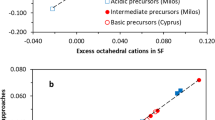Abstract
Using a simple ionic model, the energy necessary to expand a layer structure by a certain distance can be calculated. This has been done for a series of 15 structures including hydroxides, 2:1 and 1:1 structures of various types. Plots of energy versus separation distance show three major groups which have common bonding properties. For large separations, the group with the strongest interlayer bonds contains the brittle micas, the hydroxides, and the 1:1 structures. Intermediate bonding structures are the normal micas and the weakest bonds occur in the zero layer charge 2:1 structures. The relative energies needed for a given separation are not constant so that for small separations the zero layer charge structures such as talc and pyrophyllite are more strongly bonded than the normal micas. These groupings correlate very well with the expandability of the structures by water and other substances. It is proposed that this approach to the study of the layer structures will provide a simple theory explaining the expansion properties of layer silicates.
Резюме
Используя простую ионную модель,можно вычислить энергию,необходимую для расширения слоистой структуры на определенное расстояние. Это было проделано для серии из 15 структур,включая гидроокиси,структуры 2:1 и 1:1 различных типов. Графики зависимости энергии от расстояния разделения указывают на 3 главных группы,которые имеют характерные связующие свойства. При большом разделении группа с сильнейшими межслойными связями включает хрупкие слюды,гидроокиси и структуры 1:1. Структурами с промежуточными связями являются структуры нормальных слюд, и слабейшими связями обладают структуры 2:1 со слоями,имеющими нулевые заряды. Относительные величины энергии,необходимые для данного разделения,не являются постоянными.Так при небольших разделениях структуры со слоями,имеющими нулевые заряды,такие как тальк и пирофиллит,связаны сильнее,чем нормальные слюды. Это группирование очень хорошо коррелируется со способностью структур к расширению водой и другими жидкостями. Предполагается использовать этот метод для изучения слоистых структур,что обеспечит простую теорию для объяснения свойств расширения слоистых силикатов.
Similar content being viewed by others
References
Bassett, W. A. (1960) Role of hydroxyl orientation in mica alteration: Geol, Soc. Am. Bull. 71, 449–456.
Besson, G., Mifsud, A., Tchoubar, C. and Mering, J. (1974) Orderand disorder relations in the distribution of the substitutions in smectites, illites and vermiculites: Clays & Clay Minerals 22, 379–384.
Brindley, G. W. (1966) Discussions and recommendations concerning the nomenclature of clay minerals and related phyllosilicates: Clays & Clay Minerals 14, 27–34.
Brindley, G. W. (1970) Organic complexes of silicates: Reunion Hispano Belga de Minerales de la Arcilla, Madrid, 55–66.
Brindley, G. W. and Ertem, G. (1971) Preparation and solvation properties of some variable charge montmorillonites: Clays and Clay Minerals 19, 399–404.
Giese, R. F. (1973) Interlayer bonding in kaolinite, dickite and nacrite: Clays & Clay Minerals 21, 145–149.
Giese, R. F. (1974) Surface energy calculations for muscovite: Nature Phys. Science 248, 580–581.
Giese, R. F. (1975a) Interlayer bonding in talc and pyrophyllite; Clays & Clay Minerals 23, 165–166.
Giese, R. F. (1975b) The effect of F/OH substitution on some layersilicate minerals: Z. Krist. 141, 138–144.
Giese, R. F. and Datta, P. (1973) Hydroxyl orientations in kaolinite, dickite and nacrite: Am. Mineral. 58, 471–479.
Gilkes, R. J., Young, R. C. and Quirk, J. P. (1972) The oxidation of octahedral iron in biotite: Clays & Clay Minerals 20, 303–315.
Guggenheim, S. and Bailey, S. W. (1975) Refinement of the margarite structure in subgroup symmetry: Am. Mineral. 60, 1023–1029.
Giiven, N. (1971) The crystal structure of 2M1 phengite and 2M1 muscovite: Z. Krist. 134, 196–212.
Hofman, U., Weiss, A., Koch, G., Mehler, A. and Scholz, A. (1956) Intracrystalline swelling, cation exchange, and anion exchange of minerals of the montmorillonite group and of kaolinite: Clays and Clay Minerals, 4, 273–287.
Joswig, W. (1972) Neutronenbeugungsmessungen an einem 1M-Phlogopit: Neues Jahrb. Mineral. Monatsh. 1, 1–11.
Kodama, H. (1975) Diffuse scattering by X-rays and electrons in mica and mica-like minerals: Clay Mineralogy 481, 7–13.
Mackenzie, R. C. (1965) Nomenclature subcommittee of CIPEA: Clay Miner. Bull. 6, 123–126.
McCauley, J. W. and Newnham, R. E. (1973) Structure refinement of a barium mica: Z. Krist. 137, 360–367.
Mering, J. and Pedro, G. (1969) Discussion à propos des critères de classification des phyllosilicates 2/1: Bull. Groupe Fr. Argiles 21, 130.
Pedro, G. (1967) Commentaires sur la classification et la nomenclature des minéraux argileux: Bull. Groupe Fr. Argiles 19, 69–86.
Raynor, J. and Brown, G. (1973) The crystal structure of talc: Clays & Clay Minerals 21, 103–114.
Saalfeld, H. and Wedde, M. (1974) Refinement of the crystal structure of gibbsite, Al(OH)3: Z. Krist. 139, 129–135.
Sartori, F., Franzini, M. and Merlino, S. (1973) Crystal structure of a 2M2 lepidolite: Acta Crystallogr., B29, 573–578.
Smith, D. L., Milford, M. H. and Zucherman, J. J. (1966) Mechanism for intercalation of kaolinite by alkali acetates: Science 153, 741–743.
Steadman, R. and Nuttall, P. M. (1963) Polymorphism in cronstedtite: Acta Crystallogr. 16, 1–8.
Suquet, H., Iiyama, J., Kodama, H. and Pezerat, H. (1977) Synthesis and swelling properties of saponites with increasing layer charge: Clays & Clay Minerals 25, 231–242.
Wada, K. (1961) Lattice expansion of kaolin minerals by treatment with potassium acetate: Am. Mineral. 46, 78–91.
Wardle, R. and Brindley, G. W. (1972) The crystal structures of pyrophyllite, ITc, and of its dehydroxylate: Am. Mineral. 57, 732–750.
Weiss, A., Thielepape, W. and Orth, H. (1966) Neue Kaolinit Einlagerungsverbindungen: Proc. Int. Clay Congr. Stockholm 1, 287–305.
Zigan, F. and Rothbauer, R. (1967) Neutronenbeugungsmessungen am Brucit: Neues Jahrb. Mineral. Monatsh. 4/5, 137–143.
Zhoukhlistov, A., Zvyagin, B. B., Soboleva, A. V. and Fedotov, A. F. (1973) The crystal structure of the dioctahedral mica 2M2 determined by high voltage electron diffraction: Clays A Clay Minerals 21, 465–470.
Zvyagin, B. B. (1967) Electron-diffraction of Clay Mineral Structures: Plenum Press, New York, 364 pp.
Author information
Authors and Affiliations
Rights and permissions
About this article
Cite this article
Giese, R.F. The Electrostatic Interlayer Forces of Layer Structure Minerals. Clays Clay Miner. 26, 51–57 (1978). https://doi.org/10.1346/CCMN.1978.0260106
Received:
Published:
Issue Date:
DOI: https://doi.org/10.1346/CCMN.1978.0260106




